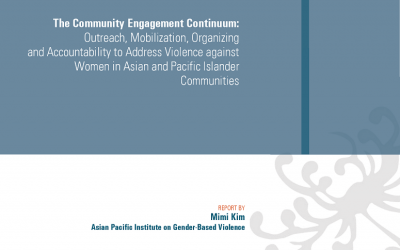Community Engagement
While the very concept of community may evoke singular feelings of hope or despair, the reality of our communities is complex and fragmented.
The community is one of the most powerful tools of the anti-violence movement, for while communities can shame, victim-blame, or prescribe harmful gender roles, they can also empower women, collaborate on prevention and intervention, and collectively shape new norms of gender democracy. Asian and Pacific Islander communities in the U.S. are embodied in high-rise public housing units and sprawling suburbs, corner groceries and rural farm lands, Christian churches, Buddhist temples, and Muslim mosques. Our attempts to engage the community are, not surprisingly, as diverse as these places and spaces in which we live and work. And as practitioners, advocates, leaders, and activists, our own relationships to the communities within which we struggle are equally varied.
The Community Engagement Continuum
We envision community engagements as anchored by four points:
-
- Community Outreach and Education raises community awareness about the issue of violence against women and children and anti-violence resources.
-
- Community Mobilization aims for active community participation and engagement supporting the anti-violence organization or addressing the problem of violence against women and children.
-
- Community Organizing involves longer-term strategies meant to increase sustained community-based capacity to address violence against women and children.
-
- Community Accountability develops the capacity of community members to support survivors and hold abusers accountable for their violence.
Resources on Community Organizing
The Community Engagement Continuum: Outreach, Mobilization, Organizing and Accountability to Address Violence against Women in Asian and Pacific Islander Communities
Community-based approaches to transform relations of power.
Community Engagement Curriculum Guide
Impact and strategies of community organizing in the anti-domestic violence movement.
Innovative Strategies to Address Domestic Violence in Asian and Pacific Islander Communities: Examining Themes, Models and Interventions, 2010
Examining the work done by API domestic violence advocates, their success, shortcomings, and future.
Hmong Women’s Dialogues Project: Our Voices Create our Future, 2006
Challenges and strategies identified by Hmong women struggling to achieve their full potential in a patriarchal society.
Community Outreach Strategies to Address Domestic Violence, 2007
Outreach and intervention community engagement strategies compiled from the work of API domestic violence advocates
Other Resources
Asian & Pacific Islander Women & Family Safety Center: Organizing With Passion: Building Relationships of Trust with Compassion, Honesty, and Creativity (2001)
Casa de Esperanza: Fuerza Unida: A Manual for Engaging Communities (2013)
Futures Without Violence: Organizing a Community-Based Response to Domestic Violence: The Filipino Experience (2014)
Wellstone: Organizing Tools

